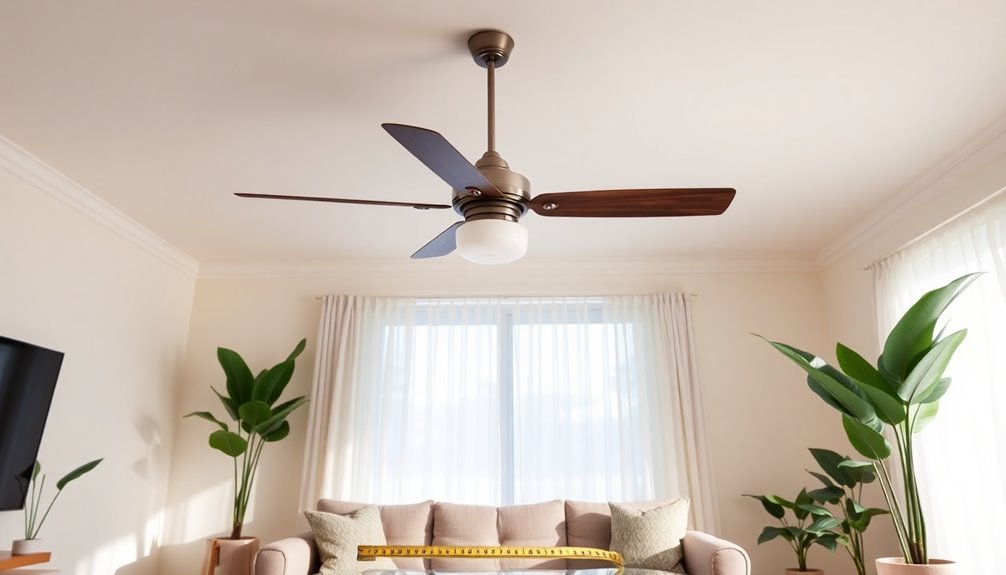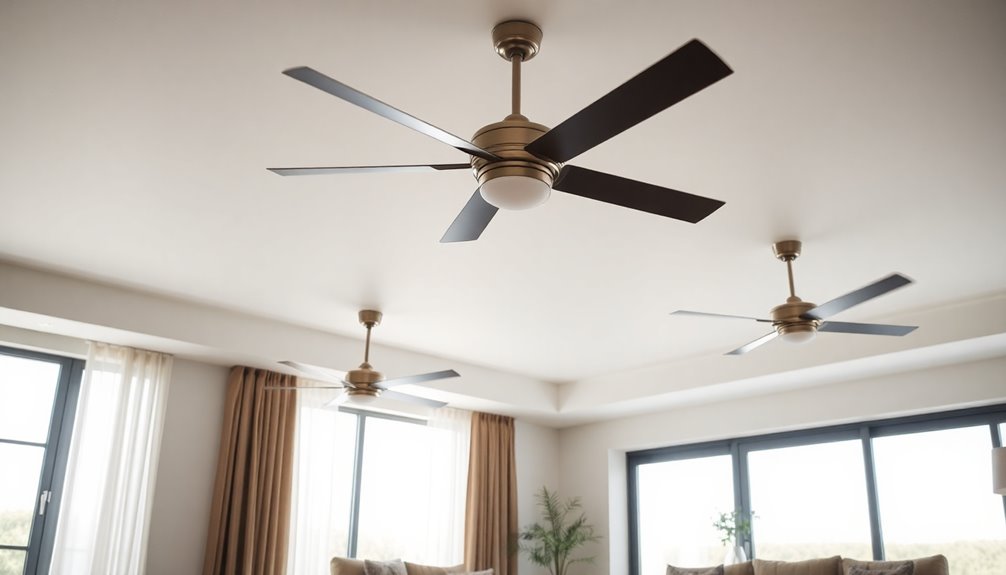When picking a ceiling fan, it's key to take into account your room size. For spaces up to 75 square feet, choose a fan that's 29 to 36 inches. If your room falls between 75 and 144 square feet, go for a 42-inch fan. Larger areas, like those between 175 to 350 square feet, need fans between 52 to 56 inches for better airflow. Always make sure the fan height allows for at least 7 feet clearance from the floor. You might find other factors, like motor types and installation tips, can also boost your fan's performance and efficiency.
Key Takeaways
- Measure your room dimensions accurately to determine the square footage for selecting the appropriate fan size.
- For rooms up to 144 sq ft, a 42-inch fan is recommended; larger rooms may require 52 to 56 inches.
- Ensure the fan is installed 8 to 9 feet above the ground for optimal airflow and safety.
- Consider motor types: DC motors are more energy-efficient than AC motors, impacting long-term electricity costs.
- Check for clearance and obstacles to ensure the fan can operate effectively without obstruction.
Measuring Room Size

When it comes to measuring room size, accuracy is key. To determine the square footage of your space, grab a tape measure and calculate the length and width. For example, if your room measures 12 by 15 feet, you're looking at 180 square feet.
If you're dealing with an L-shaped room, break it down into rectangles, measure each section, and sum the areas to get the total square footage.
Accurate room measurements are essential when selecting the right ceiling fan size. A 42-inch fan is perfect for rooms up to 144 square feet, ensuring ideal air circulation.
Don't forget to take into account your ceiling height, as this affects the downrod length you'll need for proper installation. Aim for the ideal height where the fan is about 8 to 9 feet off the ground to maximize airflow without causing a breeze that's too strong.
Measuring Ceiling Fan Size

To find the right ceiling fan size, you first need to calculate the fan diameter by measuring from the tip of one blade to the tip of the opposite blade.
Consider your room size, too; the fan's span should match your space for ideal airflow.
Calculating Fan Diameter
Determining the right ceiling fan diameter is essential for maximizing airflow and cooling efficiency in your space.
To calculate the ceiling fan diameter, you'll need to measure from the tip of one blade to the tip of the opposite blade for even-blade fans. For odd-blade fans, measure from the tip to the center and then double that measurement to get the fan span.
For ideal cooling, match the fan size to your room's square footage.
In small rooms, which are up to 75 square feet, fans should be between 29 to 36 inches in diameter.
Standard rooms of 75 to 175 square feet typically require fans sized between 42 to 48 inches.
In large rooms, measuring 175 to 350 square feet, choose fans ranging from 52 to 56 inches.
For extra-large spaces over 350 square feet, you may need fans that are 60 inches or wider.
Room Size Considerations
Measuring your room's dimensions accurately is vital for selecting the right ceiling fan size. To start, measure the length and width of your room in feet, then multiply these numbers to calculate the total square footage. This will guide you in choosing the ideal fan size based on room size considerations.
Here's a helpful reference table for ceiling fan sizing:
| Room Size (Square Footage) | Recommended Fan Size |
|---|---|
| Up to 144 | 42-inch fan |
| 144 – 225 | 44-inch fan |
| 225 – 400 | 52-inch fan |
| L-shaped rooms | Calculate each section and sum totals |
For rooms up to 144 square feet, a 42-inch fan is ideal. If your space falls between 144 and 225 square feet, a 44-inch fan will work best. For larger areas, a 52-inch fan guarantees optimal air circulation. In L-shaped rooms, divide the space into rectangles, calculate each section's square footage, and add them up to determine the right fan size. Remember, accurate measurements are vital to avoid poor air circulation and discomfort.
Determining Ceiling Fan Height

When you're choosing the right height for your ceiling fan, it's essential to take into account minimum clearance requirements for safety and airflow.
Ideally, fans should be at least 7 feet above the floor, and if your ceilings are under 8 feet, a low-profile fan is your best option.
Don't forget to account for any light kits, as they can affect the overall height and clearance needed.
Minimum Clearance Requirements
Maintaining proper clearance is vital for the safe and effective operation of your ceiling fan. You'll want to follow specific minimum clearance requirements to guarantee both airflow and safety. First, install your fan at least 7 feet above the floor. This height guarantees that occupants can move freely without risking accidental injuries.
To enhance airflow, maintain at least 8 inches of clearance between the fan blades and the ceiling. If your ceiling is under 8 feet, consider using a low-profile flush mount fan for effective air circulation. For ceilings higher than 9 feet, utilize a downrod to lower the fan to an ideal height, enhancing airflow throughout the space.
When planning your installation, keep these points in mind:
- Fan blades should have at least 12 inches of clearance from the nearest wall.
- Verify the fan is at a comfortable height to prevent any safety hazards.
- Proper mounting is essential for effective airflow and overall performance.
Ideal Mounting Options
Choosing the right mounting option for your ceiling fan is essential for maximizing both comfort and efficiency.
To guarantee peak performance, you need to evaluate the fan height based on your ceiling's size. For ceilings under 8 feet, low-profile or flush mount fans are ideal. These designs help you maintain headroom while guaranteeing proper air circulation.
Make sure your fan is mounted at least 7 feet above the floor for safety and effectiveness.
If your ceiling is between 8 and 9 feet, a standard-mount fan is suitable, requiring 12-14 inches from the ceiling to the blades. This distance allows for adequate clearance and maximizes airflow.
For ceilings higher than 9 feet, you'll want to use downrods to lower the fan to the ideal height of 8-9 feet. This positioning enhances air circulation and guarantees you get the most out of your ceiling fan size.
Calculating Downrod Length

To accurately calculate the downrod length for your ceiling fan, you should first measure your ceiling height and subtract 8 feet, which is the minimum safe distance for fan blades above the floor. This confirms you maintain ideal airflow and safety while enjoying your fan's benefits.
When determining your downrod measurement, keep these points in mind:
- Standard fan housing typically measures between 8 to 12 inches.
- For ceilings higher than 9 feet, a downrod is necessary for effective air circulation.
- Reference charts provide recommended downrod lengths based on various ceiling heights.
For example, if your ceiling height is 10 feet, using a 12-inch downrod would position the fan approximately 8 feet above the floor. This setup adheres to ceiling fan guidelines, confirming proper fan installation and maximizing air circulation.
Additional Considerations

When it comes to selecting the right ceiling fan, there are several additional factors you should keep in mind. First, consider light kits, as they can increase the overall height of the fan, requiring you to measure clearance from the ceiling. Confirm your ceiling can support the weight of the fan to avoid safety hazards.
Next, look for obstacles like beams or light fixtures that may obstruct the fan blades. These can hinder airflow and reduce the fan's efficiency.
If your ceiling height is angled between 34 to 56 degrees, you'll need angle mount fans for proper airflow and stability. Thorough measurements of your room dimensions and ceiling height are vital for effective cooling and comfort.
| Factor | Importance |
|---|---|
| Clearance | Required for safety |
| Obstacles | Affects airflow |
| Support Weight | Guarantees fan stability |
Ceiling Fan Size and Airflow

Choosing the appropriate size ceiling fan is essential for attaining ideal airflow in your space. The fan size, determined by its blade span, must correspond to your room's square footage to guarantee optimal airflow. For instance, a 42-inch fan works well in areas up to 144 sq ft.
- Picture a cozy 12×12-foot room with a fan that perfectly fits its dimensions.
- Imagine a spacious living area where a larger fan enhances air circulation without overwhelming the decor.
- Visualize the aesthetic balance created when the fan diameter complements the room's style.
For small rooms (up to 100 sq ft), fans measuring 29-36 inches are ideal. In contrast, large rooms (up to 400 sq ft) require fans with a span of 50-71 inches.
A fan's CFM (cubic feet per minute) rating also plays a role; fans rated between 3,000-5,000 CFM are best for medium-sized spaces.
Ceiling Fan Motor Types

Understanding the differences between ceiling fan motor types can greatly impact your comfort and energy efficiency. Ceiling fan motors primarily come in two types: AC motors and DC motors.
AC motors are the most common and economical choice, featuring three speed settings and straightforward installation, making them suitable for residential use. However, if you're looking for energy efficiency, DC motors are the way to go. They offer a wider speed range, faster startup, and consume notably less energy, which can lead to lower electricity bills over time.
While DC motors may have a higher upfront cost, their long-term savings and performance benefits often outweigh this initial investment.
Keep in mind that fans with DC motors may require an adapter depending on your home's electrical system, so checking for compatibility is essential before making a purchase.
Ultimately, the choice between AC and DC motors will depend on your specific needs and preferences for air flow and energy efficiency. By understanding these motor types, you can make a more informed decision that enhances both your comfort and your home's energy efficiency.
Installation and Maintenance Tips

Proper installation and regular maintenance are essential for guaranteeing your ceiling fan operates efficiently and safely. When you're ready for ceiling fan buying, remember that the electrical box must be compatible and securely mounted, typically requiring a metal box for safety.
Follow the installation manual closely to avoid accidents and to ensure peak performance.
To enhance your experience, keep these tips in mind:
- Maintain a minimum clearance of 8 feet between the fan blades and the floor for safe operation and peak airflow.
- Regularly clean the fan blades and housing to prevent dust buildup, which can hinder performance and efficiency.
- If you're uncertain about the installation process, it's wise to hire a qualified electrician to guarantee safety and compliance with local electrical codes.
Frequently Asked Questions
Is a 52 Inch Fan Too Big for a 12X12 Room?
Yes, a 52-inch fan is likely too big for your 12×12 room.
It can overwhelm the space, creating a drafty feeling rather than a comfortable breeze. For a room this size, you should consider a fan around 44 inches at most.
This size guarantees effective airflow without discomfort and maintains the room's aesthetic appeal.
Choosing the right fan size helps you enjoy the perfect balance of cooling and style in your space.
How Do I Choose the Right Size Ceiling Fan?
To choose the right size ceiling fan, start by measuring your room's dimensions.
Multiply the length by the width to find the square footage.
Next, match this size to the appropriate fan blade span.
For ideal airflow, consider the fan's CFM rating, ensuring it fits your space's needs.
Don't forget to keep at least 12 inches of clearance between the fan blades and walls for safety and effective circulation.
Is a 3/4 or 5 Blade Ceiling Fan Better?
Imagine stepping into a room that feels perfectly cool and inviting.
When choosing between a 3 or 5-blade ceiling fan, think about your space and needs. A 3-blade fan's efficiency and quietness shine in larger areas, while a 5-blade fan delivers consistent airflow in smaller spaces.
Consider your design preferences, too; do you want a sleek, modern look or something more traditional?
Ultimately, it's about finding what makes you feel most comfortable.
What Size Room for a 52 Inch Ceiling Fan?
When considering a 52-inch ceiling fan, you'll want to think about your room size.
This fan suits spaces between 225 and 400 square feet, making it ideal for larger rooms or open-concept areas.
If your room is around 12 x 15 feet, a 44-inch fan might be a better fit.
Always verify you maintain at least 18 inches of clearance from walls for maximum airflow and performance.
Conclusion
So, you've picked the perfect ceiling fan size, nailed down the height, and calculated the downrod length—congratulations! You've clearly mastered the art of ceiling fan selection. Ironically, after all that effort, it might just be the subtle breeze from your windows that cools the room. But hey, at least you've got a stylish fan to admire. Just remember, whether it's spinning or still, your comfort is what truly matters—fan or no fan!









